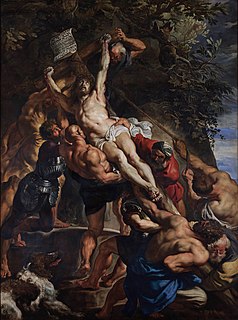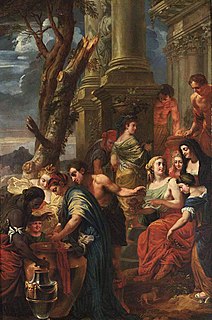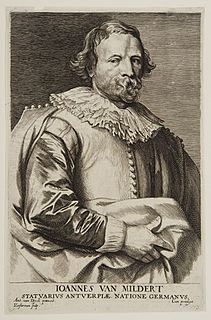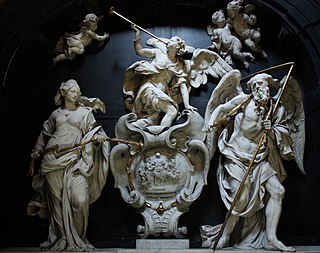Related Research Articles
Quellinus is the surname of a family of Flemish artists, painters and sculptors active in the 17th century in Antwerp. Members of the family include:

Baroque sculpture is the sculpture associated with the Baroque style of the period between the early 17th and mid 18th centuries. In Baroque sculpture, groups of figures assumed new importance, and there was a dynamic movement and energy of human forms—they spiralled around an empty central vortex, or reached outwards into the surrounding space. Baroque sculpture often had multiple ideal viewing angles, and reflected a general continuation of the Renaissance move away from the relief to sculpture created in the round, and designed to be placed in the middle of a large space—elaborate fountains such as Gian Lorenzo Bernini‘s Fontana dei Quattro Fiumi, or those in the Gardens of Versailles were a Baroque speciality. The Baroque style was perfectly suited to sculpture, with Bernini the dominating figure of the age in works such as The Ecstasy of St Theresa (1647–1652). Much Baroque sculpture added extra-sculptural elements, for example, concealed lighting, or water fountains, or fused sculpture and architecture to create a transformative experience for the viewer. Artists saw themselves as in the classical tradition, but admired Hellenistic and later Roman sculpture, rather than that of the more "Classical" periods as they are seen today.

Artus Quellinus the Elder, Artus Quellinus I or Artus (Arnoldus) Quellijn was a Flemish sculptor. He is regarded as the most important representative of the Baroque in sculpture in the Southern Netherlands. He worked for a long period in the Dutch Republic and operated large workshops both in Antwerp and Amsterdam. His work had a major influence on the development of sculpture in Northern Europe.

Erasmus Quellinus the Younger or Erasmus Quellinus II (1607–1678) was a Flemish painter, engraver, draughtsman and tapestry designer who worked in various genres including history, portrait, allegorical, battle and animal paintings. He was a pupil of Peter Paul Rubens and one of the closest collaborators of Rubens in the 1630s. Following Rubens' death in 1640 he became one of the most successful painters in Flanders. He was a prolific draughtsman who made designs for decorative programmes in the context of official celebrations, for publications by the local publishers and for tapestries and sculptures realised by the local workshops. His work reveals the Classicist trend in the Baroque.

Pieter Verbrugghen I was a Flemish sculptor from the Baroque.

Artus Wolffort, Artus Wolffaert or Artus Wolffaerts (1581–1641) was a Flemish painter known mainly for his history paintings depicting religious and mythological scenes.

Flemish Baroque painting refers to the art produced in the Southern Netherlands during Spanish control in the 16th and 17th centuries. The period roughly begins when the Dutch Republic was split from the Habsburg Spain regions to the south with the Spanish recapturing of Antwerp in 1585 and goes until about 1700, when Spanish Habsburg authority ended with the death of King Charles II. Antwerp, home to the prominent artists Peter Paul Rubens, Anthony van Dyck, and Jacob Jordaens, was the artistic nexus, while other notable cities include Brussels and Ghent.

Jan Erasmus Quellinus was a Flemish painter and draughtsman and a member of the famous Quellinus family of artists. He was one of the last prominent representatives of the great Flemish school of history and portrait painting in the 17th century. His work displays the classicizing influences of his father Erasmus Quellinus the Younger and Paolo Veronese. Mainly active in his native Antwerp, he worked for some time in Vienna for the Habsburg court as a court painter to Emperor Leopold I.

Willem van Herp (I) or Willem van Herp the Elder was a Flemish Baroque painter specializing in religious paintings and small cabinet paintings of "low-life" genre scenes. He operated a large workshop and through his good connections with Antwerp art dealers helped spread the Flemish Baroque style internationally.

Hubertus Quellinus or Hubert Quellinus was a Flemish printmaker, draughtsman and painter and a member of the prominent Quellinus family of artists. His engravings after the work of his brother, the Baroque sculptor Artus Quellinus the Elder, were instrumental in the spread of the Flemish Baroque idiom in Europe in the second half of the 17th century.

Wilhelm Schubert van Ehrenberg or Willem Schubart van Ehrenberg (also: Wilhem Schubert von Ehrenberg or Wilhem Schubert van Ehrenberg was a Flemish painter mainly active in Antwerp who specialized in architectural paintings including of real and imaginary church interiors, Renaissance palaces and picture galleries.

Hendrik Frans Verbrugghen or Hendrik Frans Verbruggen was a Flemish sculptor and draftsman, who is best known for his Baroque church furniture in various Belgian churches.

Pieter Verbrugghen the Youngeror Pieter Verbrugghen II(1648, Antwerp - after 1691, Antwerp) was a Flemish sculptor, draughtsman, etcher and stone merchant.

Johannes van Mildert or Hans van Mildert was a Flemish sculptor, who is best known for his baroque sculptures found in many Belgian and Dutch churches. Van Mildert played an important role in the development of the design of Flemish Baroque religious furniture.

Mattheus van Beveren was a Flemish sculptor and medalist who is mainly known for his monumental Baroque church sculptures and small wood and ivory sculptures. He also made medals and die designs for the Antwerp Mint.

The St. Paul's Church or Sint-Pauluskerk is a Roman Catholic church located at the Veemarkt in Antwerp. Its exterior is mainly Gothic with a Baroque tower while the interior is characterised by its rich Baroque decoration. It holds paintings by Antwerp's leading artists Peter Paul Rubens, Anthony van Dyck and Jacob Jordaens as well as abundant sculpture and church furniture crafted by leading Antwerp sculptors such as Artus Quellinus the Elder, Pieter Verbrugghen I, Jan Pieter van Baurscheit de Elder, Jan Claudius de Cock and Andries Colyns de Nole. Of particular note is the Calvary outside the Church which is made up of 63 life-size statues and nine reliefs executed in a popular and theatrical style.

Artus Quellinus II or Artus Quellinus the Younger was a Flemish sculptor who played an important role in the evolution of Northern-European sculpture from High Baroque to Late Baroque.

The Brueghel family, also spelled Bruegel or Breughel, is an extended family of Flemish painters which played a major role in the development of the art in Flanders throughout the 16th and 17th centuries. Due to the organisation in guilds and training being done with established painters and not in schools or academies, painters often passed on the knowledge from father to son, and there are many examples of Flemish painting families spanning two or more generations, e.g. the Francken family, which had at least ten painters spanning four generations. The Brueghel family produced the largest number of major painters of all Flemish families.

Lodewijk Willemsens or Ludovicus Willemsens (1630–1702) was a Flemish sculptor from Antwerp. His works comprise mostly sculptured church furniture, and to a lesser extent individual sculptures, both portrait busts as well as statues of saints for churches.

Bartholomeus Eggers was a Flemish sculptor, who after training in his hometown Antwerp spent most of his active career in the Dutch Republic. Here he initially collaborated with other Flemish sculptors on the sculptural decorations for the new city hall in Amsterdam, a project which was under the direction of Artus Quellinus the Elder. He worked on various public projects and on commissions for leading courts in Europe. He is known for his portraits, funerary sculptures, reliefs, statues of children and allegorical, biblical and mythological sculptures. He was, together with Artus Quellinus the Elder and Rombout Verhulst, one of the leading sculptors active in the Dutch Republic in the second half of the 17th century.
References
- 1 2 3 4 Hans Vlieghe and iris Kockelbergh. "Quellinus." Grove Art Online. Oxford Art Online. Oxford University Press. Web. March 23. 2014
- ↑ Biographical details at the Netherlands Institute for Art History (in Dutch)
- 1 2 Helena Bussers, De baroksculptuur en het barok at Openbaar Kunstbezit Vlaanderen (in Dutch)
- ↑ Pulpit in the St. Gummarus Church in Lier (in Dutch)